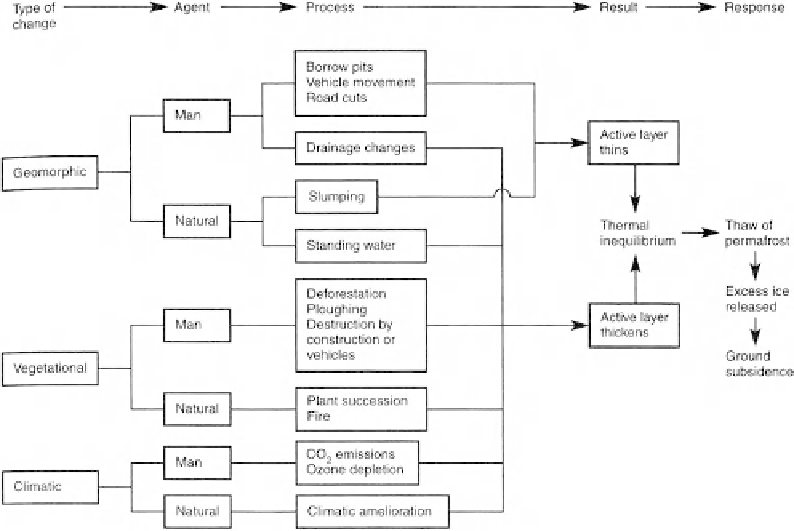Geology Reference
In-Depth Information
Figure
8.2.
Diagram illustrating how geomorphic, vegetational, and climatic changes may lead to
permafrost degradation.
between regional climate warming that occurs on a time scale of 10
−4
to 10
−6
years from
that which occurs on a time scale of 10
−1
years. For example, many periglacial environ-
ments are paraglacial in nature and, as such, have experienced an overall progressive
amelioration of climate during the past 10 000-15 000 years following retreat of the Late-
Pleistocene ice sheets. Equally, ongoing global warming trends of the last 100 years,
irrespective of whether they are natural or anthropogenic, are capable of increasing
thermokarst activity. Finally, economic activities, such as construction, land clearance, or
terrain disturbance, may initiate thermokarst activity on a time scale of less than a
decade.
In reality, any increase in mean annual temperature probably leads to a diminution of
heat exchange in the soil and a lower summer soil temperature. This is because it would
most likely be associated with an increase in precipitation and cloud cover. As a result,
there would be a decrease in thaw depth. This is the exact opposite to what is required
for thermokarst development. Therefore, the simplest condition for the onset of thermokarst
is a progressive increase in continentality of climate. This results in a greater range of soil
temperatures and summer thaw depths. However, recent global warming scenarios suggest
that increases in winter temperatures and snowfall amounts will be greatest in the high
latitudes. As a result, any predictions concerning an increase in thermokarst activity in
response to global climate change are problematic.
In central and northern Siberia thermokarst has occurred on a regional scale (Czudek
and Demek, 1970; Romanovskii et al., 2000) and over extended periods of fl uctuating
cold-climate conditions during the Quaternary and throughout the Holocene. This
refl ects the never-glaciated history of much of the area. The distinctive thermokarst
terrain of central Yakutia is discussed later in this chapter while that of coastal lowlands

